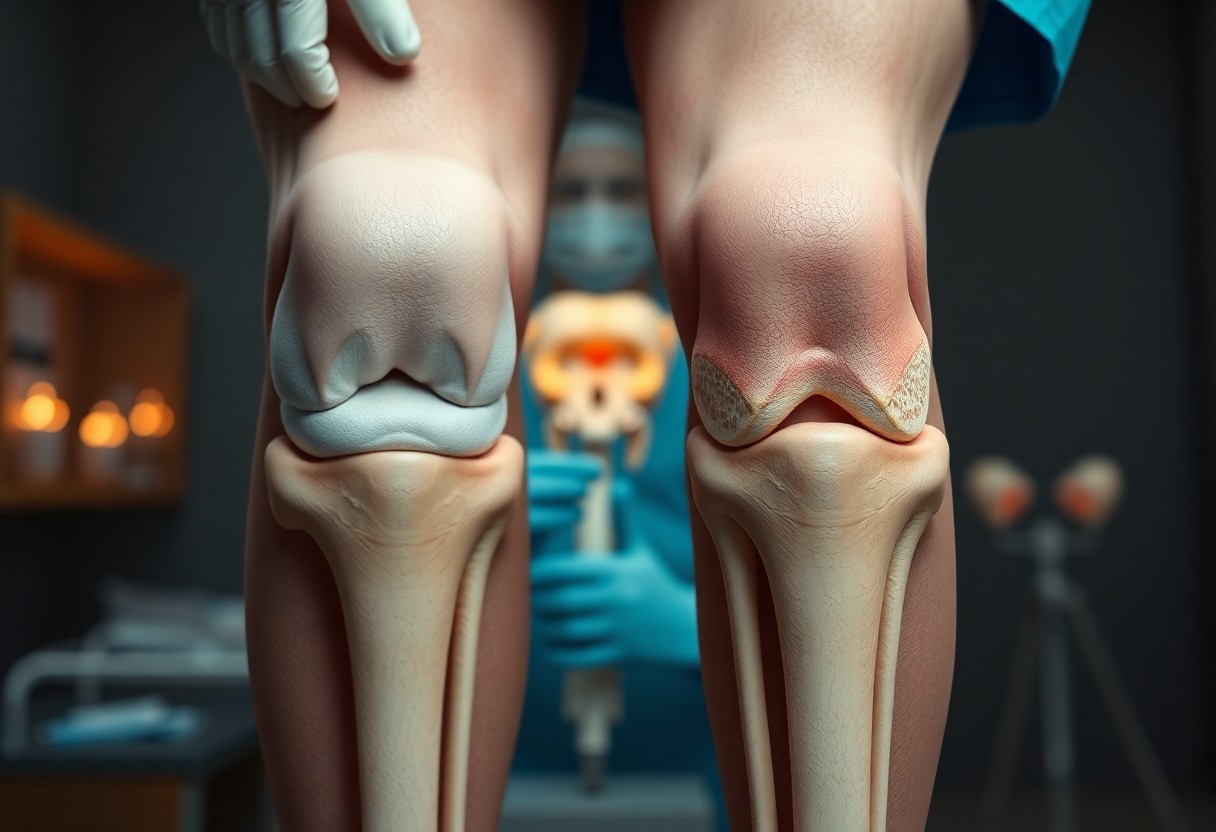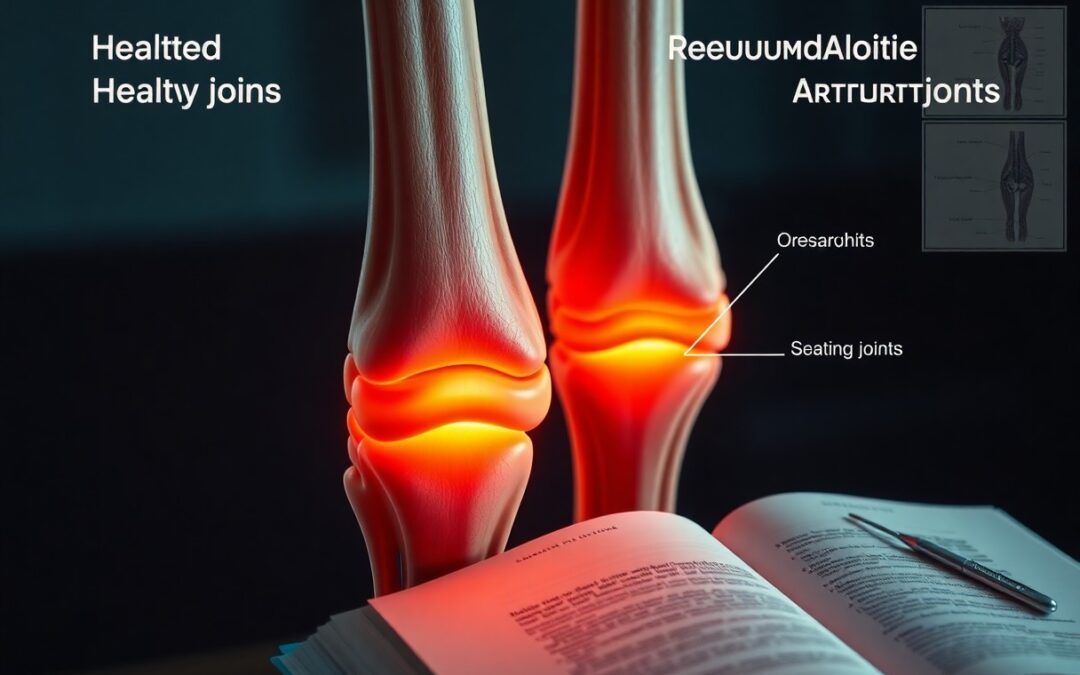Many individuals experience the challenges of arthritis, yet many do not fully understand its two most common forms: osteoarthritis and rheumatoid arthritis. By gaining insight into the underlying causes, symptoms, and treatment options for these conditions, you can take proactive steps toward improving your joint health. This blog post aims to clarify these two types of arthritis, helping you make informed choices for your wellness journey.
The Biomechanics of Joint Deterioration
Understanding the biomechanics of joint deterioration reveals how both osteoarthritis and rheumatoid arthritis affect your body. Every time you move, forces act on your joints, and over time, these forces can lead to wear and tear. Bone alignment, muscle strength, and overall joint stability all play vital roles in the health of your joints. Poor posture, imbalanced muscle function, and repetitive stress can exacerbate joint damage, making it vital to address these factors for better joint health.
How Cartilage Breaks Down
Your cartilage, the protective cushion at the ends of bones, starts to break down as a result of chronic inflammation and mechanical stress. This degradation leads to a reduction in shock absorption and joint stability, making movement painful. Osteoarthritis, in particular, is characterized by the gradual loss of this cartilage, often beginning in the weight-bearing joints such as the knees and hips.
The Role of Synovial Fluid in Joint Health
Synovial fluid plays a critical role in lubricating your joints, allowing for smooth movement and reducing friction. When your joints function properly, this viscous fluid nourishes the cartilage and acts as a shock absorber, protecting your bones from wear. Changes in the quality or quantity of synovial fluid can significantly impact joint health, leading to pain and stiffness.
Influencing factors such as age, injury, and inflammation can impair the production or function of synovial fluid. For instance, in rheumatoid arthritis, the synovial membrane becomes inflamed, leading to excessive fluid production that can ultimately result in joint swelling and discomfort. Maintaining optimal levels of synovial fluid is vital for your joints to remain healthy and agile, highlighting the importance of staying active and engaged in joint-friendly exercises.

Osteoarthritis: The Degenerative Menace
Your joints bear the brunt of daily activities, and over time, the wear and tear can lead to osteoarthritis (OA)—a degenerative condition that impacts millions worldwide. It occurs when the cartilage cushioning the ends of your bones gradually breaks down, resulting in pain, stiffness, and reduced mobility. Often affecting weight-bearing joints like the knees, hips, and spine, osteoarthritis can significantly diminish your quality of life. Early recognition and management are imperative to navigate this progressive ailment effectively.
Risk Factors and Early Symptoms
Multiple factors contribute to the development of osteoarthritis. Age, genetics, obesity, joint injury, and repetitive stress on your joints all play a role. Early symptoms often manifest as joint pain and swelling, particularly after activity. You might also notice stiffness in the morning or after sitting for prolonged periods. Awareness of these indicators can lead to timely intervention.
- Age – Increased risk as you get older
- Obesity – Extra weight adds strain to your joints
- Joint injuries – Previous damage can lead to OA later
- Genetics – Family history can increase likelihood
- Repetitive stress – Frequent use of joints in certain jobs or activities
Recognizing these factors can be a game-changer in managing your joint health. Tailoring your approach to lifestyle changes can slow the progression of OA. Emphasizing a balanced diet, maintaining an active lifestyle with low-impact exercises, and managing weight significantly mitigate symptoms. Alongside physical therapy, over-the-counter pain relievers or prescribed medications can further enhance joint function. Interventions like corticosteroid injections may also alleviate inflammation when necessary. Each strategy aims to empower you in your journey towards better joint health.
Management Strategies and Interventions
Effective management strategies for osteoarthritis focus on both symptomatic relief and improving joint function. Your treatment plan may include physical therapy to strengthen muscles around the affected joints, thereby providing added support and stability. Incorporating low-impact exercises, such as swimming or cycling, can enhance flexibility while minimizing stress on the joints. Nutrition also plays a key role; a diet rich in omega-3 fatty acids and antioxidants can reduce inflammation. Non-stick medicinal options like acetaminophen or NSAIDs, prescribed as needed, assist with pain relief.
Complementary therapies, such as acupuncture or massage, may also provide additional relief. For more advanced cases, your healthcare provider might suggest surgical options like joint replacement or arthroscopy to remove damaged tissue. Staying proactive about joint care by regularly discussing your symptoms with your healthcare provider sets you on a path toward improved mobility and an overall better quality of life.
Rheumatoid Arthritis: An Autoimmune Challenge
Rheumatoid arthritis (RA) stands out among arthritis types as an autoimmune disorder, where your immune system mistakenly attacks the synovium—the lining of your joints. Unlike osteoarthritis, which typically results from wear and tear, RA can affect any joint and often occurs in a symmetrical pattern. This means that if one hand is affected, the other is likely to feel the impact as well. Early diagnosis and treatment are vital in managing RA’s progression and maintaining your quality of life.
The Mechanisms of Inflammation
In rheumatoid arthritis, your immune system triggers inflammation in the synovial tissue, leading to increased production of inflammatory cells and proteins. This inflammatory response drives pain, swelling, and stiffness in the joints. As the condition progresses, the persistent inflammation can erode cartilage and bone, resulting in joint deformities and loss of mobility. Understanding these mechanisms helps to emphasize the importance of timely intervention in RA.
Long-term Implications and Treatment Options
The long-term implications of untreated rheumatoid arthritis can be severe, including joint deformities, reduced function, and systemic effects such as cardiovascular disease. Treatment often involves a combination of medications—nonsteroidal anti-inflammatory drugs (NSAIDs), disease-modifying antirheumatic drugs (DMARDs), and sometimes biologics—to manage symptoms and slow disease progression. Regular monitoring and adjustments to your treatment plan are important to address the dynamic nature of RA.
Managing rheumatoid arthritis effectively requires a comprehensive approach. Embracing lifestyle changes, such as incorporating gentle physical activity and a balanced diet rich in anti-inflammatory foods, can support joint health. Regular consultations with your healthcare team ensure that medication regimens are optimized, minimizing side effects while maximizing efficacy. Engaging in physical therapy may also be beneficial, as it helps improve strength and flexibility. Ultimately, a proactive strategy can significantly enhance your ability to live well with RA, allowing you to engage fully in your daily activities.
Everyday Practices to Enhance Joint Health
Incorporating everyday practices into your routine can significantly boost joint health and overall well-being. Focusing on nutrition, exercise, and mindfulness will foster resilience in your joints, keeping you active and pain-free. These simple lifestyle choices can make a big difference, enabling you to manage the discomfort associated with arthritis more effectively.
Nutrition: Foods That Foster Joint Resilience
Your diet plays a pivotal role in joint health. Incorporating anti-inflammatory foods such as fatty fish rich in omega-3 fatty acids, colorful fruits and vegetables, nuts, and whole grains can help reduce inflammation and support joint function. Foods loaded with antioxidants, like berries and leafy greens, also contribute to overall joint resilience, keeping discomfort at bay.
Exercise: Building Strength Without Strain
Low-impact exercises, such as swimming, cycling, and yoga, provide effective ways to build strength while being gentle on your joints. Aim for 30 minutes of moderate activity most days, focusing on flexibility, range of motion, and strengthening exercises tailored to your comfort level, allowing you to maintain function without exacerbating pain.
Engaging in regular exercise not only builds the muscle surrounding your joints but also promotes joint stability. Activities like tai chi focus on balance and strengthen your core, which can alleviate pressure on your knees and hips. Strength training with resistance bands can also be adjusted to your fitness level, enhancing muscle support for your joints and reducing the risk of injury. Staying consistent with these exercises helps maintain mobility and improves your overall quality of life as you manage arthritis symptoms.
The Psychological Impact of Living with Arthritis
Living with arthritis goes beyond physical pain; it often leads to emotional challenges such as anxiety, depression, and a sense of isolation. Many people with arthritis struggle to maintain a positive outlook due to the unpredictable nature of their symptoms. This psychological burden can contribute to a cycle of pain and distress, making it vital to address both physical and mental health aspects for comprehensive management of the condition.
Coping Mechanisms and Support Systems
Establishing coping mechanisms and support systems plays a vital role in managing the psychological toll of arthritis. Engaging in support groups, whether online or in person, allows you to share experiences and gather emotional strength from others facing similar challenges. Incorporating relaxation techniques such as yoga or meditation can also enhance your resilience, providing both mental clarity and physical relief.
The Importance of Mental Health in Chronic Pain Management
Maintaining mental health throughout chronic pain management significantly improves your overall well-being. Effective treatment of arthritis often requires integrating psychological support, as emotional distress can worsen your perception of pain and decrease your quality of life. Engaging in cognitive behavioral therapy or mindfulness practices can help you develop healthier responses to pain and enhance your ability to cope with its impact.
Research shows that individuals with chronic pain conditions, including arthritis, who actively participate in mental health treatment can report reduced pain levels and improved functionality. For instance, a study published in the Journal of Pain found that patients who used cognitive-behavioral therapy experienced a significant decrease in pain intensity and disruption to daily activities. By addressing your mental health, you not only improve emotional resilience but also enhance your physical management strategies, making day-to-day activities more enjoyable.
To wrap up
Summing up, understanding osteoarthritis and rheumatoid arthritis is important for managing your joint health effectively. By recognizing the differences between these two types of arthritis, you can make informed decisions about your treatment options and lifestyle adjustments. Incorporating regular exercise, a balanced diet, and consulting with healthcare professionals can greatly enhance your quality of life. Empower yourself with knowledge, and take proactive steps towards maintaining the health and functionality of your joints.

